The Vikings in North America
This viking settlement site which dates from circa 1000 A.D., and which is accepted as having only been occupied for a few years, features the remains of eight buildings together with evidence of iron-working and boat repair.
In these times Norse peoples, or Vikings, had long been active as traders and settlers, as intrepid sailors and as formidable raiders.
"Normandy" became established in France, a Danelaw was established in England, Iceland and Greenland were also subject to Norse or Viking colonisation.
The small scale and brief settlement at L'Anse aux Meadows can be seen as something of a venturesome outpost established by Norsemen or Vikings from established Norse communities on Iceland or Greenland.
Greenland itself seems to have only been reached by the Vikings in about 985 A.D.
A Norseman known as Erik the Red had sailed there with his companions after being banished from Iceland due to some violent behaviors.
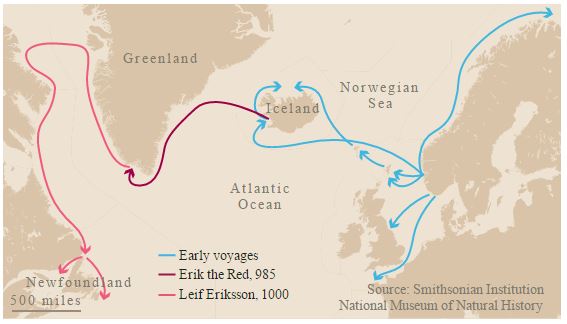
Newfoundland / early Viking voyages in the North Atlantic
Two Icelandic Sagas ~ the Saga of Erik the Red and the Saga of the Greenlanders ~ mention lands lying to the west of Iceland and Greenland and recount how Leif Eriksson discovered a land he called Vinland in his western voyaging sometime around 1000 A.D.
Mention is also made in the Sagas of some even earlier Viking landfalls off ~ possibly ~ American shores, where sailors blown off course by storms sighted land but did not actually set foot on the shores they had seen.
The discovery of the camp or settlement at L'Anse aux Meadows in 1960 was in large part inspired by these ancient Norse Sagas.
This historic mentioning of "Vinland" was conciously followed up many centuries later by a Norwegian explorer named Helge Ingstad and his archaeologist wife Anne Stine Ingstad. Their attempts to find the truth about Vinland led directly to their discoveries about L'Anse aux Meadows actually being a Norse settlement site rather than being the "old indian camp" that local people had presumed it to be.
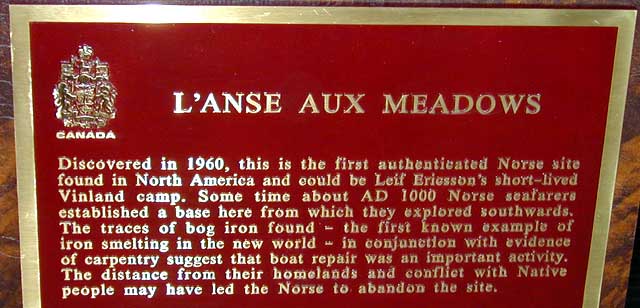
Interpretive plaque standing at L'Anse aux Meadows
L'Anse aux Meadows is deemed to be of great cultural significance and was recognised by UNESCO as one of its proclaimed World Heritage Sites in 1978.
As of 2016 another "possible" North American viking settlement had been newly identified, - again on the island of Newfoundland, - and radio-carbon dateable to 800-1270 A.D. - a range inclusive of those times when Norse settlement was present in the north americas at L'Anse aux Meadows.
By the summer of 2018, however, the possibilities of this 'new site' actually being Norse were being
largely discounted. It may nevertheless be of interest to outline why serious archaeological researchers were excited by the potential of Point Rosee seemed to initially have as a Norse settlement site.
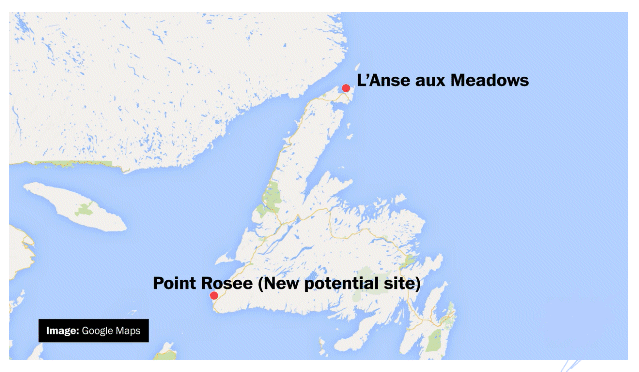
The ~ possible ~ new settlement is located
at Point Rosee in south-west Newfoundland
The new discovery at Point Rosee sits on a narrow, windswept peninsula stretching from south-western Newfoundland into the Gulf of St. Lawrence and lies some 300 miles south of L'Anse aux Meadows.
This existence of this, proposed, settlement site was initially indicated by examination of open-source imagery found on Google Earth. Tens of thousands square kilometers of coastline were considered in the original assessment process which utilised freely available imagery. This preliminary consideration yielded some fifty sites which were deemed to be of potential archaeological interest and which were selected for more detailed consideration.
More detailed data was requested from providers of high-definition aerial surveys. The research team opted to concentrate further investigation initially on just six, then on just two, of these fifty sites. Due to the very steep fees demanded it was only as the candidate sites became lessened in number that data was meaningfully requested from providers of space satellite high-definition and near infrared remote-sensing services.
Some initial ground survey work done in 2014 showed one of these sites to have some problematic issues.
Point Rosee was now the only remaining site and seemed to show particularly interesting features; that is to say these features were held to be of interest to archaeologists because they were possibly man-made.
One of these features appeared to have internal divisions and is almost the exact size and shape of longhouses uncovered at L'Anse aux Meadows. One of the lead researchers, Sarah Parcak, is on record as saying of the site ~ "It screams, 'Please excavate me!'"
The Point Rosee site itself, located on a small grassy headland surrounded on three sides by the sea.
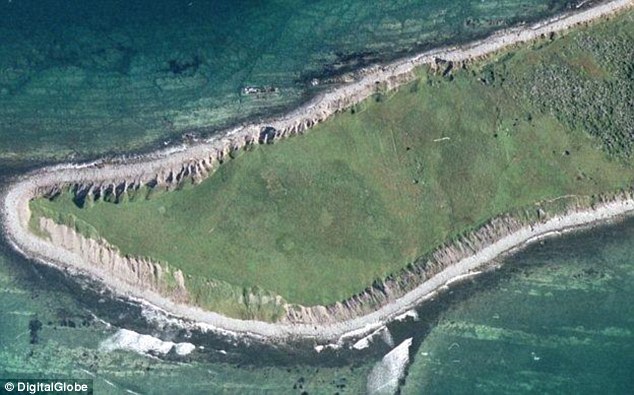
Satellite image by Digital Globe
The remnants of buried structures alter the surrounding soils, changing the amount of moisture they retain. This, in turn, affects vegetation growth. Using certain remote sensing techniques, variations in plant growth form a spectral outline of what was there centuries earlier. The Point Rosee images were intentionally taken during the fall, when the grasses in the area were particularly high, making it easier to see which plants were healthier; better enabled to absorb more water from the underlying soils.
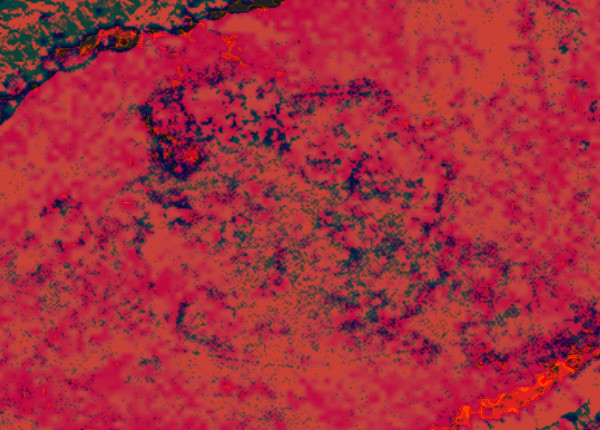
Image by Digital Globe interpreted in terms of plant health
The viability of those soils, in relation to vegetation growth, being affected by the remnants of long-buried underlying structures leading to subtle, but detectable differences in plant chlorophyll endowment.
Sarah Parcak has previously been very directly involved in archaeological investigations utilising space satellite remote-sensing.
She, (together with diverse highly qualified colleagues), has already made highly important discoveries in relation to the archaeology of Ancient Egypt and of Ancient Rome.
Much about the findings she and her colleagues have made has been presented in documentaries such as Egypt's Lost Cities, Rome's Lost Empire, Rome: What Lies Beneath and (now) The Vikings Uncovered.
Very reputable organisations such as the BBC, National Geographic and PBS NOVA have been variously involved in the production and broadcasting of these documentaries.
Sarah Parcak was initially reluctant to become involved in a hunt for archaeological evidence of the Vikings having been in North America when it was suggested to her by the BBC.
She seems to have attempted to fend-off such encouragements believing that the making of such efforts would not only be largely a waste of time but would also tend to associate herself with what had become seen - rightly or wrongly, in the long absence of further discovery since 1960 and the findings at L'Anse aux Meadows, as something of a lost cause pursued by "amateurs" and "mavericks."
In a subsequent Yale lecture she portrayed her attitude at the time as being one of - "I don't want to be one of these crazy people."
She also seemed to have considered that she, and other team members she was used to working alongside in archaeological investigations, would have been at something of a loss as to know what to look for in unfamiliar parts of the world historically inhabited by peoples whose culture practices, buildings, and other artifacts she did not know all that much about.
Dr Greg Mumford, her husband and collaborator in archaeological investigations was, however, a long-term Viking enthusiast and was rather in favor of taking on the project.
When encouragements from the BBC and other high-profile entities continued, and when funding was made available from several such sources including National Geographic, she did agree to participation in the undertaking of such studies.
It would seem that in doing so she was nevertheless acting under the presumption that nothing of note was likely to be found.
A revealing "The Late Show with Stephen Colbert" interview with "Space Archaeologist" Sarah Parcak is available on YouTube!!!
Initial hands-on archaeological investigations of the Point Rosee site were conducted over two and a half weeks in June, 2015, and have revealed some extremely suggestive results.
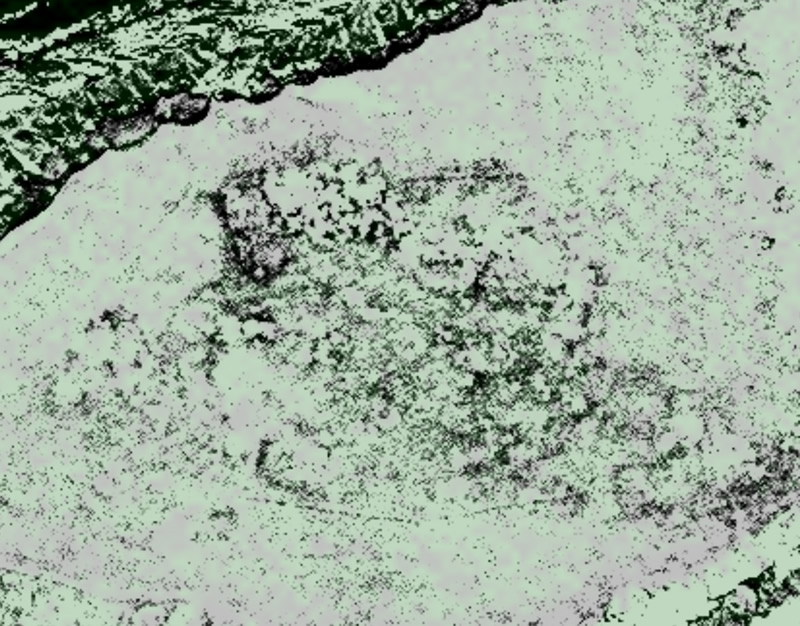
Satellite image by Digital Globe
Trench excavations exposed traces that were interpreted as being evidence of the historical presence of viking-style turf walls. Ash residues were also discovered as well as an iron-bearing material presumed to be a processing residue known as "slag" and a fire-cracked boulder.
These discoveries were held to be signs of metallurgy not associated with the historic peoples accepted as being native the region. An interpretation made more convincing when a metallurgy expert ruled that the "slag" was in fact roasted bog-iron ore.
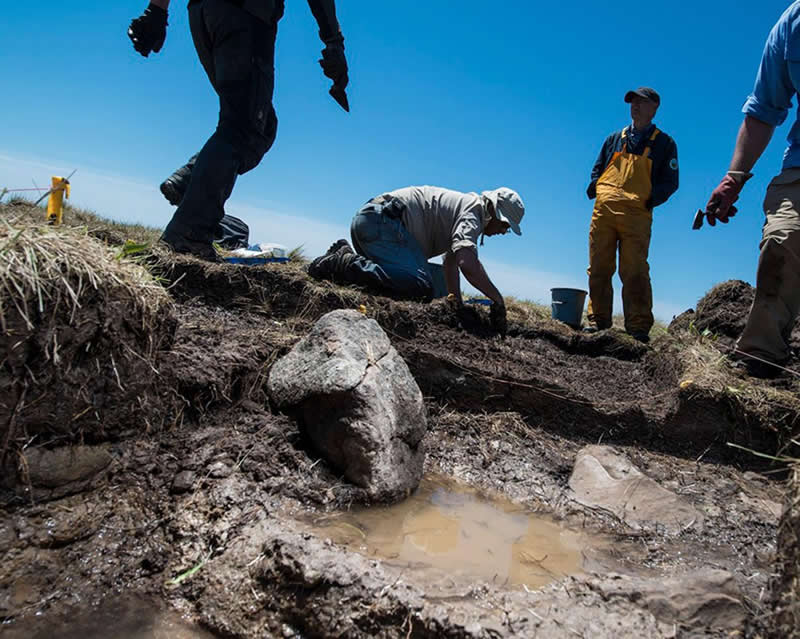
Photograph by Robert Clark - National Geographic
The 18 pounds / 8 kilos of iron bearing material found in a "stone-lined bowl" feature located at the base of this fire-cracked boulder, suggest that this was a hearth used for the roasting out of a dried and iron-rich ore that was better suited further processing. Samples of this roasted-out ore proved under analysis to be 85%-90% iron.
Some of the turf walling discovered lay very close to this hearth site ~ a site which scientific "magnetometer" sensing methods had pin-pointed for investigative excavation.
In the opinion of the research team the positioning of this turf walling, laid out as it seems to have been in a "L" shape, could have facilitated the passage of air towards the hearth.
Fishermen and whalers from the Basque country are known to have had some presence in Newfoundland dating from the 16th century but they are also not known for utilising the metallurgical techniques revealed by the research team. The smelting of iron by way of an initial roasting of bog-iron is, in fact, seen as being unique to the Norse culture of these centuries. Radio-carbon dating shows that these findings related to metallurgy pre-date the accepted times of Basque fishermen being present in Newfoundland.
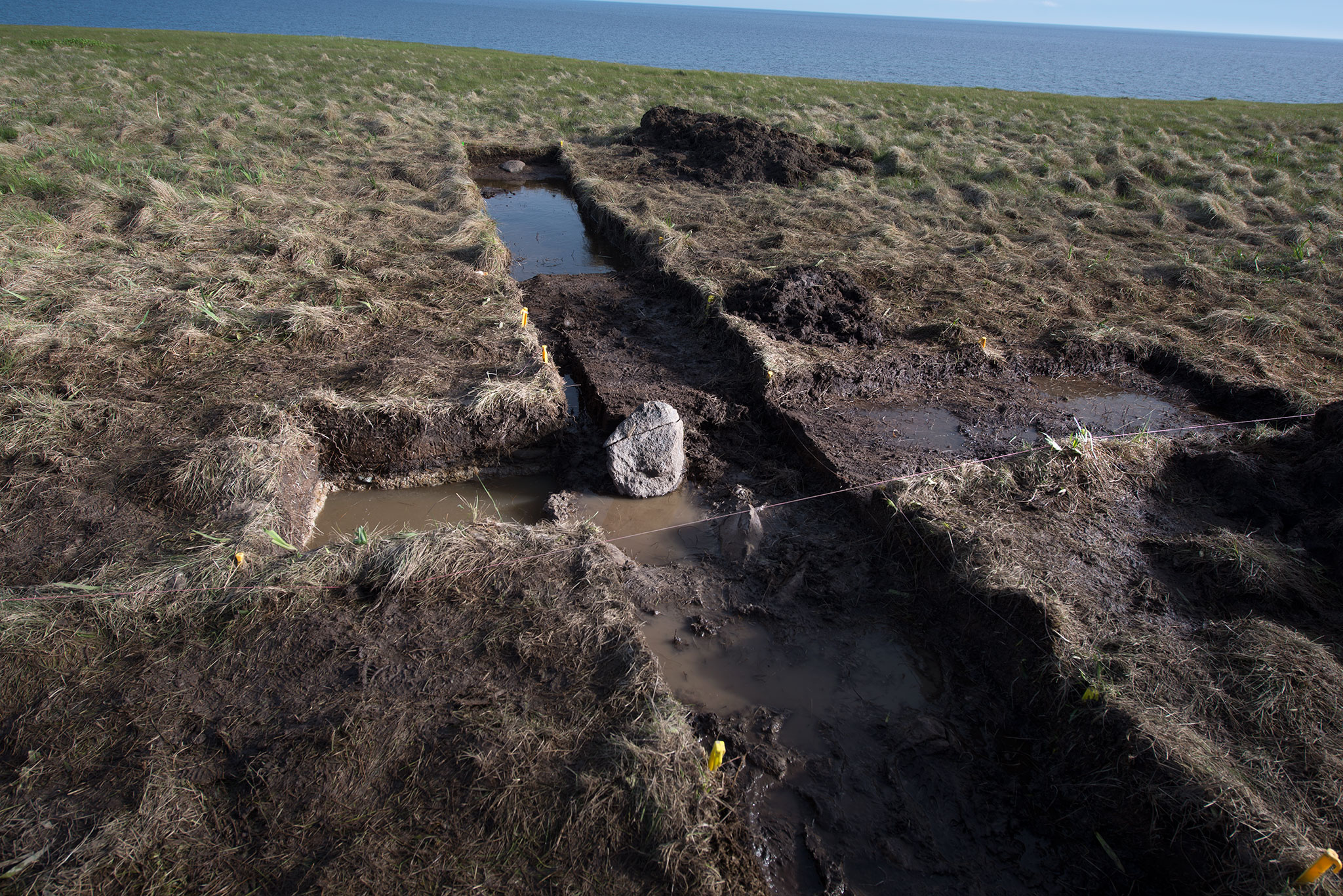
Initial excavations of this "possible" bog-iron roasting hearth
The Vikings and Norse peoples sourced most of their iron from peat bogs and did not tend to engage in actual mining activities.
This bog-iron being accessible as an iron-rich material that forms when rivers carry dissolved particles of iron down from mountains and into wetlands where somewhat concentrated iron-bearing deposits can then be left behind.
The viking way-of-life was highly dependent on supplies of iron for weapons and tools. Iron nails were critically necessary to the building and repairing of their ships.
As with L'Anse aux Meadows bog-iron deposits were able to be accessed at Point Rosee.
It has been estimated that the full construction of a viking ship of those times would have necessitated the processing of some 30 tons of this bog-iron material.
The absence of historical objects pointing to any other cultures than that of the Vikings at Point Rosee has significantly helped in convincing the archaeologists involved in the project of the site's immense promise as a, potential, Norse or Viking settlement site.
And again, (speaking about the Point Rosee discoveries during a phone interview with The Washington Post):-
"We did not find one single shred of any [contradictory] evidence, so that leaves two options. It's either a new culture that looks and presents exactly like Norse, or Norse. But obviously we have a lot of work left in front of us before we can say beyond a shadow of a doubt that it is."
As of April, 2016, she firmly declines to actually claim Point Rosee is reliably established as having been a Viking or Norse settlement site:-
"I hate, as an archeologist ... to say it's definitely Norse," she said. "We absolutely cannot say that right now."
"A lot of people in the press are calling this a Norse settlement. We absolutely cannot call it a settlement."
"If it is Norse, the most we can say right now is that it's a small farm or perhaps a temporary winter camp."
She had earlier gone on record as saying:-
"We have the second pre-Colombian iron processing site in North America," she said. "I feel very comfortable saying that."

It should be recognised, however, that since the first announcement of the team's findings in 2015 there has been a lessening of confidence in their initially accepted discoveries.
This video relates something of the hesitancy that has now set in after some further, and intensive, on-site investigations that were conducted in the summer of 2016:-

The term pre-Colombian in relation to both North America and South America refers to those swathes of time prior to Christopher Columbus' widely accepted "Discovery of America" of 1492 A.D..
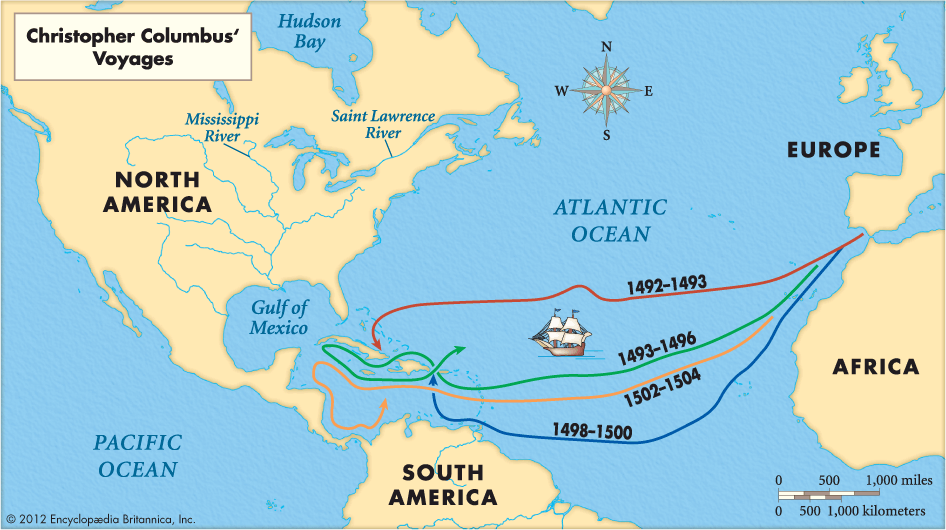
Christopher Columbus' voyages of 1492 - and later
One of Columbus' aspirations in 1492 had been seeking a more direct, westerly, sea-route to The Indies and to Cathay, (i.e. the Spice Islands and China), for trading purposes.
European trading voyages had, at that time, to sail far to the south and actually round the southern cape of Africa and then cross the Indian Ocean in order to reach the Spice Islands!
Columbus land-fall in the "West Indies" of 1492 soon thereafter led to the realisation, by Europeans, that an hitherto unsuspected "New World" existed across the Atlantic.

Another of Sarah Parcak's comments sounds quite distinctly upbeat:-
As things stand the discovery of a second known pre-Columbian iron-processing site in the North Americas would be, if definitely proven in and of itself, a really Big Deal.
Another intriguing find at Point Rosee was that of seeds of a type of butternut tree which is not held to have grown on the island of Newfoundland; thus hinting at southerly voyagings
to milder climates in the Gulf of St. Lawrence.
Seeds of the butternut tree have also been found at L'Anse aux Meadows!
Moreover the name "Vinland" appears in the Norse Sagas in relation to the more southerly shores visited by Leif Eriksson. In some scholars' opinions "Vinland" is directly translatable from old Norse as "Wineland." Depending on the presence or absence of accent marks on individual letters in the spelling out of the word Vinland other scholars see more merit in a translation which suggests pasturelands.
Whilst some of the land close by Point Rosee is amongst the most suited to farming on Newfoundland grapes, alike with butternut trees, do not occur naturally on the island.
The closest extreme northern locations, where it is accepted that grapes can flourish lies pretty much due west of Point Rosee, but on the shores of "the North American continent / Canada's province of New Brunswick."
At this same location butternut trees can also grow and produce their seeds!

It could be that the evidence of Butternuts at Point Rosee is a result of a brief stop-over that Vikings made as they voyaged from northern Newfoundland / L'Anse aux Meadows towards milder regions on the western shores of the Gulf of St. Lawrence.
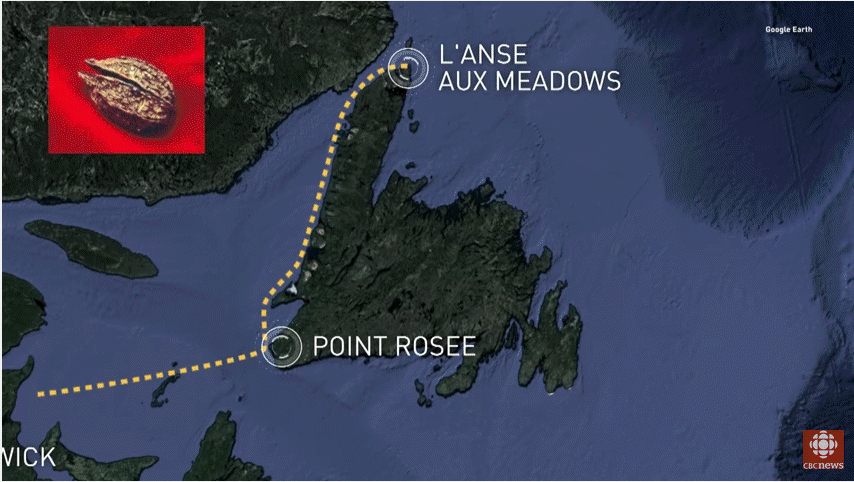

The confirmed discovery of the Viking settlement site at L'Anse aux Meadows has effectively proved that the Norse Sagas weren't entirely fiction. A second settlement at Point Rosee would, if confirmed, surely tend to suggest that the Norse exploration of the region wasn't a limited undertaking, and that archaeologists should expand their search for evidence of other - North American - Viking or Norse settlements.
Such settlements could potentially have been built some 500 years before Christopher Columbus' "Discovery of America."
"For a long time, serious North Atlantic archaeologists have largely ignored the idea of looking for Norse sites in coastal Canada because there was no real method for doing so," says Douglas Bolender, an archaeologist specializing in Norse settlements. "If Sarah Parcak can find one Norse site using satellites, then there's a reasonable chance that you can use the same method to find more, if they exist. If Point Rosee is Norse, it may open up coastal Canada to a whole new era of research."
Again according to Douglas Bolender:-
"We could end up with a much longer period of Norse activity in the New World. A site like Point Rosee has the potential to reveal what that initial wave of Norse colonization looked like not only for Newfoundland but for the rest of the North Atlantic."
Intensive achaeological investigations of the site are projected to resume in the summer of 2016.
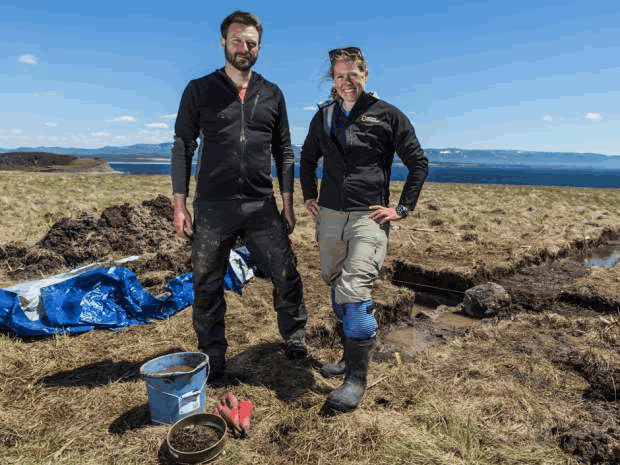
Norse specialist Bolender and Space Archaeologist Parcak
Some considerable skepticism still remains about any possible future discoveries. According to Douglas Bolender:-
A PRI interview with Dr Sarah Parcak is available here:-
The researchers hope in the near future to unearth materials which will enable a narrowing of the radio-carbon dating of the site to a more precise range than the present 800-1270 A.D.
It would seem that the seemingly rich promise inherent in the research findings thus far, and the undoubtedly very high-profile context of a potential "newly discovered Norse or Viking settlement in North America," has led to offerings of assistance from a number of world-leading authorities in diverse fields of expertise relevant to the full appreciation and interpretation of any further discoveries that may be made.
Space satellite remote sensing techniques have also been recently applied to the L'Anse aux Meadows site and have revealed that much more of archaelogical interest still remains there to be excavated and reliably interpreted.

What is less widely appreciated is that such major World Faiths as Christianity, Islam, Hinduism, Buddhism and Sikhism see "Spirituality" as being relative to "Desire" and to "Wrath".
Human Being seems
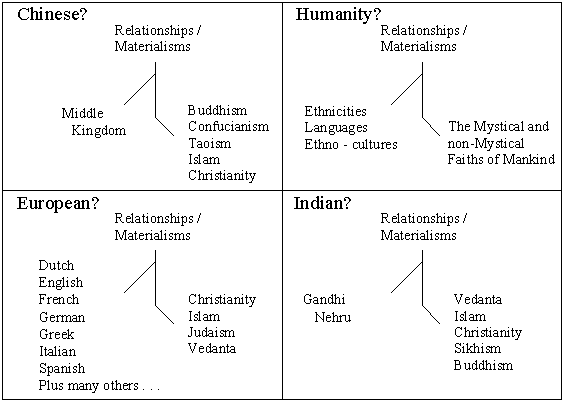
A collection of authoritative key insights ~ from the Great Faiths, Plato, Socrates, Pythagoras, Shakespeare and Emerson ~,
and give convincing support to such a view of Human Nature as this!!!
Believe it or not even SCIENCE seems to broadly agree with such a view as this!!!
"...man is a bundle of relations, a knot of roots,
whose flower and fruitage is the world..."
Ralph Waldo Emerson

This view suggests that Societies themselves!!! can often have a Tripartite character.
To quote Emerson, from his famous Essay ~ History more fully:-
In old Rome the public roads beginning at the Forum proceeded north, south, east, west, to the centre of every province of the empire, making each market-town of Persia, Spain, and Britain pervious to the soldiers of the capital: so out of the human heart go, as it were, highways to the heart of every object in nature, to reduce it under the dominion of man. A man is a bundle of relations, a knot of roots, whose flower and fruitage is the world. His faculties refer to natures out of him, and predict the world he is to inhabit, as the fins of the fish foreshow that water exists, or the wings of an eagle in the egg presuppose air. He cannot live without a world.


The ~ possible ~ new settlement is located
at Point Rosee in south-west Newfoundland
The new discovery at Point Rosee sits on a narrow, windswept peninsula stretching from south-western Newfoundland into the Gulf of St. Lawrence and lies some 300 miles south of L'Anse aux Meadows.
This existence of this, proposed, settlement site was initially indicated by examination of open-source imagery found on Google Earth. Tens of thousands square kilometers of coastline were considered in the original assessment process which utilised freely available imagery. This preliminary consideration yielded some fifty sites which were deemed to be of potential archaeological interest and which were selected for more detailed consideration.
More detailed data was requested from providers of high-definition aerial surveys. The research team opted to concentrate further investigation initially on just six, then on just two, of these fifty sites. Due to the very steep fees demanded it was only as the candidate sites became lessened in number that data was meaningfully requested from providers of space satellite high-definition and near infrared remote-sensing services.
Some initial ground survey work done in 2014 showed one of these sites to have some problematic issues.
Point Rosee was now the only remaining site and seemed to show particularly interesting features; that is to say these features were held to be of interest to archaeologists because they were possibly man-made.
One of these features appeared to have internal divisions and is almost the exact size and shape of longhouses uncovered at L'Anse aux Meadows. One of the lead researchers, Sarah Parcak, is on record as saying of the site ~ "It screams, 'Please excavate me!'"
The Point Rosee site itself, located on a small grassy headland surrounded on three sides by the sea.

Satellite image by Digital Globe
The remnants of buried structures alter the surrounding soils, changing the amount of moisture they retain. This, in turn, affects vegetation growth. Using certain remote sensing techniques, variations in plant growth form a spectral outline of what was there centuries earlier. The Point Rosee images were intentionally taken during the fall, when the grasses in the area were particularly high, making it easier to see which plants were healthier; better enabled to absorb more water from the underlying soils.

Image by Digital Globe interpreted in terms of plant health
The viability of those soils, in relation to vegetation growth, being affected by the remnants of long-buried underlying structures leading to subtle, but detectable differences in plant chlorophyll endowment.
Sarah Parcak has previously been very directly involved in archaeological investigations utilising space satellite remote-sensing.
She, (together with diverse highly qualified colleagues), has already made highly important discoveries in relation to the archaeology of Ancient Egypt and of Ancient Rome.
Much about the findings she and her colleagues have made has been presented in documentaries such as Egypt's Lost Cities, Rome's Lost Empire, Rome: What Lies Beneath and (now) The Vikings Uncovered.
Very reputable organisations such as the BBC, National Geographic and PBS NOVA have been variously involved in the production and broadcasting of these documentaries.
Sarah Parcak was initially reluctant to become involved in a hunt for archaeological evidence of the Vikings having been in North America when it was suggested to her by the BBC.
She seems to have attempted to fend-off such encouragements believing that the making of such efforts would not only be largely a waste of time but would also tend to associate herself with what had become seen - rightly or wrongly, in the long absence of further discovery since 1960 and the findings at L'Anse aux Meadows, as something of a lost cause pursued by "amateurs" and "mavericks."
In a subsequent Yale lecture she portrayed her attitude at the time as being one of - "I don't want to be one of these crazy people."
She also seemed to have considered that she, and other team members she was used to working alongside in archaeological investigations, would have been at something of a loss as to know what to look for in unfamiliar parts of the world historically inhabited by peoples whose culture practices, buildings, and other artifacts she did not know all that much about.
Dr Greg Mumford, her husband and collaborator in archaeological investigations was, however, a long-term Viking enthusiast and was rather in favor of taking on the project.
When encouragements from the BBC and other high-profile entities continued, and when funding was made available from several such sources including National Geographic, she did agree to participation in the undertaking of such studies.
It would seem that in doing so she was nevertheless acting under the presumption that nothing of note was likely to be found.
A revealing "The Late Show with Stephen Colbert" interview with "Space Archaeologist" Sarah Parcak is available on YouTube!!!
Initial hands-on archaeological investigations of the Point Rosee site were conducted over two and a half weeks in June, 2015, and have revealed some extremely suggestive results.

Satellite image by Digital Globe
Trench excavations exposed traces that were interpreted as being evidence of the historical presence of viking-style turf walls. Ash residues were also discovered as well as an iron-bearing material presumed to be a processing residue known as "slag" and a fire-cracked boulder.
These discoveries were held to be signs of metallurgy not associated with the historic peoples accepted as being native the region. An interpretation made more convincing when a metallurgy expert ruled that the "slag" was in fact roasted bog-iron ore.

Photograph by Robert Clark - National Geographic
The 18 pounds / 8 kilos of iron bearing material found in a "stone-lined bowl" feature located at the base of this fire-cracked boulder, suggest that this was a hearth used for the roasting out of a dried and iron-rich ore that was better suited further processing. Samples of this roasted-out ore proved under analysis to be 85%-90% iron.
Some of the turf walling discovered lay very close to this hearth site ~ a site which scientific "magnetometer" sensing methods had pin-pointed for investigative excavation.
In the opinion of the research team the positioning of this turf walling, laid out as it seems to have been in a "L" shape, could have facilitated the passage of air towards the hearth.
Fishermen and whalers from the Basque country are known to have had some presence in Newfoundland dating from the 16th century but they are also not known for utilising the metallurgical techniques revealed by the research team. The smelting of iron by way of an initial roasting of bog-iron is, in fact, seen as being unique to the Norse culture of these centuries. Radio-carbon dating shows that these findings related to metallurgy pre-date the accepted times of Basque fishermen being present in Newfoundland.

Initial excavations of this "possible" bog-iron roasting hearth
The Vikings and Norse peoples sourced most of their iron from peat bogs and did not tend to engage in actual mining activities.
This bog-iron being accessible as an iron-rich material that forms when rivers carry dissolved particles of iron down from mountains and into wetlands where somewhat concentrated iron-bearing deposits can then be left behind.
The viking way-of-life was highly dependent on supplies of iron for weapons and tools. Iron nails were critically necessary to the building and repairing of their ships.
As with L'Anse aux Meadows bog-iron deposits were able to be accessed at Point Rosee.
It has been estimated that the full construction of a viking ship of those times would have necessitated the processing of some 30 tons of this bog-iron material.
The absence of historical objects pointing to any other cultures than that of the Vikings at Point Rosee has significantly helped in convincing the archaeologists involved in the project of the site's immense promise as a, potential, Norse or Viking settlement site.
And again, (speaking about the Point Rosee discoveries during a phone interview with The Washington Post):-
"We did not find one single shred of any [contradictory] evidence, so that leaves two options. It's either a new culture that looks and presents exactly like Norse, or Norse. But obviously we have a lot of work left in front of us before we can say beyond a shadow of a doubt that it is."
As of April, 2016, she firmly declines to actually claim Point Rosee is reliably established as having been a Viking or Norse settlement site:-
"I hate, as an archeologist ... to say it's definitely Norse," she said. "We absolutely cannot say that right now."
"A lot of people in the press are calling this a Norse settlement. We absolutely cannot call it a settlement."
"If it is Norse, the most we can say right now is that it's a small farm or perhaps a temporary winter camp."
She had earlier gone on record as saying:-
"We have the second pre-Colombian iron processing site in North America," she said. "I feel very comfortable saying that."

It should be recognised, however, that since the first announcement of the team's findings in 2015 there has been a lessening of confidence in their initially accepted discoveries.
This video relates something of the hesitancy that has now set in after some further, and intensive, on-site investigations that were conducted in the summer of 2016:-

The term pre-Colombian in relation to both North America and South America refers to those swathes of time prior to Christopher Columbus' widely accepted "Discovery of America" of 1492 A.D..

Christopher Columbus' voyages of 1492 - and later
One of Columbus' aspirations in 1492 had been seeking a more direct, westerly, sea-route to The Indies and to Cathay, (i.e. the Spice Islands and China), for trading purposes.
European trading voyages had, at that time, to sail far to the south and actually round the southern cape of Africa and then cross the Indian Ocean in order to reach the Spice Islands!
Columbus land-fall in the "West Indies" of 1492 soon thereafter led to the realisation, by Europeans, that an hitherto unsuspected "New World" existed across the Atlantic.

Another of Sarah Parcak's comments sounds quite distinctly upbeat:-
"Typically in archaeology, you only ever get to write a footnote in the history books, but what we seem to have at Point Rosee may be the beginning of an entirely new chapter.
This new site could unravel more secrets about the Vikings whether they were the first Europeans to 'occupy' briefly in North America and reveal that the Vikings dared to explore much further into the New World than we ever thought."
This new site could unravel more secrets about the Vikings whether they were the first Europeans to 'occupy' briefly in North America and reveal that the Vikings dared to explore much further into the New World than we ever thought."
As things stand the discovery of a second known pre-Columbian iron-processing site in the North Americas would be, if definitely proven in and of itself, a really Big Deal.
Point Rosee and Vinland
Seeds of the butternut tree have also been found at L'Anse aux Meadows!
Moreover the name "Vinland" appears in the Norse Sagas in relation to the more southerly shores visited by Leif Eriksson. In some scholars' opinions "Vinland" is directly translatable from old Norse as "Wineland." Depending on the presence or absence of accent marks on individual letters in the spelling out of the word Vinland other scholars see more merit in a translation which suggests pasturelands.
Whilst some of the land close by Point Rosee is amongst the most suited to farming on Newfoundland grapes, alike with butternut trees, do not occur naturally on the island.
The closest extreme northern locations, where it is accepted that grapes can flourish lies pretty much due west of Point Rosee, but on the shores of "the North American continent / Canada's province of New Brunswick."
At this same location butternut trees can also grow and produce their seeds!

It could be that the evidence of Butternuts at Point Rosee is a result of a brief stop-over that Vikings made as they voyaged from northern Newfoundland / L'Anse aux Meadows towards milder regions on the western shores of the Gulf of St. Lawrence.


The confirmed discovery of the Viking settlement site at L'Anse aux Meadows has effectively proved that the Norse Sagas weren't entirely fiction. A second settlement at Point Rosee would, if confirmed, surely tend to suggest that the Norse exploration of the region wasn't a limited undertaking, and that archaeologists should expand their search for evidence of other - North American - Viking or Norse settlements.
Such settlements could potentially have been built some 500 years before Christopher Columbus' "Discovery of America."
"For a long time, serious North Atlantic archaeologists have largely ignored the idea of looking for Norse sites in coastal Canada because there was no real method for doing so," says Douglas Bolender, an archaeologist specializing in Norse settlements. "If Sarah Parcak can find one Norse site using satellites, then there's a reasonable chance that you can use the same method to find more, if they exist. If Point Rosee is Norse, it may open up coastal Canada to a whole new era of research."
Again according to Douglas Bolender:-
"We could end up with a much longer period of Norse activity in the New World. A site like Point Rosee has the potential to reveal what that initial wave of Norse colonization looked like not only for Newfoundland but for the rest of the North Atlantic."
Intensive achaeological investigations of the site are projected to resume in the summer of 2016.

Norse specialist Bolender and Space Archaeologist Parcak
Some considerable skepticism still remains about any possible future discoveries. According to Douglas Bolender:-
"What we're really going to be looking for is an overwhelming amount of evidence that will include additional, very clear Norse-style architecture and ideally, distinctive Norse
artifacts… This is the kind of thing where experts in the field, myself included… come with a huge amount of skepticism, and very appropriate skepticism. There are always
claims about these sites in North America. Most of them do not pan out."
A PRI interview with Dr Sarah Parcak is available here:-
The researchers hope in the near future to unearth materials which will enable a narrowing of the radio-carbon dating of the site to a more precise range than the present 800-1270 A.D.
It would seem that the seemingly rich promise inherent in the research findings thus far, and the undoubtedly very high-profile context of a potential "newly discovered Norse or Viking settlement in North America," has led to offerings of assistance from a number of world-leading authorities in diverse fields of expertise relevant to the full appreciation and interpretation of any further discoveries that may be made.
Space satellite remote sensing techniques have also been recently applied to the L'Anse aux Meadows site and have revealed that much more of archaelogical interest still remains there to be excavated and reliably interpreted.

Explore Inner Space!!!
It is widely known that Plato, pupil of and close friend to Socrates, accepted that Human Beings have a " Tripartite Soul " where individual Human Psychology is composed of three aspects - Wisdom-Rationality, Spirited-Will and Appetite-Desire.What is less widely appreciated is that such major World Faiths as Christianity, Islam, Hinduism, Buddhism and Sikhism see "Spirituality" as being relative to "Desire" and to "Wrath".
Human Being seems
to be rather "Tripartite"

A collection of authoritative key insights ~ from the Great Faiths, Plato, Socrates, Pythagoras, Shakespeare and Emerson ~,
and give convincing support to such a view of Human Nature as this!!!
Believe it or not even SCIENCE seems to broadly agree with such a view as this!!!
"...man is a bundle of relations, a knot of roots,
whose flower and fruitage is the world..."
Ralph Waldo Emerson

This view suggests that Societies themselves!!! can often have a Tripartite character.
To quote Emerson, from his famous Essay ~ History more fully:-
In old Rome the public roads beginning at the Forum proceeded north, south, east, west, to the centre of every province of the empire, making each market-town of Persia, Spain, and Britain pervious to the soldiers of the capital: so out of the human heart go, as it were, highways to the heart of every object in nature, to reduce it under the dominion of man. A man is a bundle of relations, a knot of roots, whose flower and fruitage is the world. His faculties refer to natures out of him, and predict the world he is to inhabit, as the fins of the fish foreshow that water exists, or the wings of an eagle in the egg presuppose air. He cannot live without a world.

